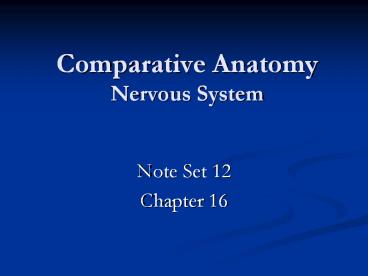Comparative Anatomy Nervous System - PowerPoint PPT Presentation
1 / 29
Title:
Comparative Anatomy Nervous System
Description:
Comparative Anatomy Nervous System Note Set 12 Chapter 16 Primary Brain Vesicles Prosencephalon (Forebrain) Smell Mesoncephalon (Midbrain) Vision Rhombencephalon ... – PowerPoint PPT presentation
Number of Views:2224
Avg rating:3.0/5.0
Title: Comparative Anatomy Nervous System
1
Comparative AnatomyNervous System
- Note Set 12
- Chapter 16
2
Primary Brain Vesicles
- Prosencephalon (Forebrain)
- Smell
- Mesoncephalon (Midbrain)
- Vision
- Rhombencephalon (Hindbrain)
- Hearing
Figure 15.1 Primary brain vessicles (book figure
16.13).
3
Primary Brain Vesicles (cont)
Figure 15.2 Basic brain plan.
Figure 15.3 Brain divisions.
4
Hindbrain
- Myelencephalon
- Medulla oblongata
- Involuntary reflexes
- Vagal lobe
- Metencephalon
- Cerebellum
- Roof of metencephalon
- Reflex control of skel. muscle
- Pons
Figure 15.4 Neural tube development.
5
Hindbrain (cont)
- Lateral ventricles
- Two cerebral hemispheres
- Posterior choroid plexus
- Roof in hindbrain
- 4th ventricle tissue
- Cerebral spinal fluid
- Tela choroidea
- Roof of medulla
- Thin membrane
Figure 15.5 Choroid plexus shown of larval
anuran (book figure 16.18).
6
Divisions and Vesicles
Figure 15.6 Divisions of the brain and
ventricles numbered.
7
Midbrain
- No subdivisions
- Optic lobes
- Optic reflex centers
- Well developed in birds
- Auditory lobes
- Caudal to optic lobes
- Superior (optic) and inferior (auditory)
colliculi- when lobes occur together - Corpora quadrigemina collectively
Figure 15.7 Mesoncephalon and tectum region.
8
Midbrain (cont)
- 3rd ventricle
- Optic ventricles- extension to optic lobe
- Ventricles disappear in higher phylogeny
- Cerebral aqueduct
- Restricted passageways
- Conducts 3rd and 4th ventricle
- Aqueduct of Sylvius when restricted further
Figure 15.8 Cerebral aqueduct and ventricles of
brain.
9
Forebrain- Diencephalon
- Optic chiasma
- Two optic nerves cross
- Pituitary gland
- Caudal to optic chiasma
- Saccus vasculosus
- Posterior to pituitary in some fish
- Depth receptor
Figure 15.9 Regions of the diencephalon of a
shark with third ventricle in red (book figure
16.19).
10
Forebrain- Diencephalon (cont)
- Hypothalamus
- Floor of diencephalon
- Autonomic nervous system
- Thalamus
- Walls of diencephalon
- 3rd ventricle cavity
- Communicates with lateral ventricles
- Foramen of Monro
Figure 15.10 Medial view of the brain showing
thalamus and hypothalamus of the diencephalon.
11
Forebrain- Diencephalon (cont)
- Epithalamus
- Several evaginations
- Roof of diencephalon
- Paraphysis anteriorly
- Epiphyseal complex
- Pineal
- Photoreceptors
- Parapineal
- Pineal eye (3rd eye)
Figure 15.11 Epithalamus gross mid-sagittal
section of the human brain.
Figure 15.12 Pineal in detail (book figure
16.24).
12
Forebrain- Telencephalon
- Cerebral hemispheres posterior
- Rhinencephalon anterior
- Olfaction
- Lower vertebrates
- Rhinencephalon prominent
- Hemispheres smaller
- Higher vertebrates
- Hemispheres increase in size
- Olfactory get smaller
Figure 15.13 Front section of cerebral
hemisphere formation (book figure 16.13).
13
Craniate Brains
Figure 15.14 Craniate brains.
14
Craniate Brains (cont)
Figure 15.15 Dorsal view of craniate brains
(book figure 16.14).
15
Fish Cerebrum
- Primitive sensory
- Pallium- dorsal area
- Motor area
- Subpallium- ventral area
- Globus pallidus (Striatum)
Figure 15.16 Globus pallidus of fish left
cerebral hemisphere (book figure 16.25).
16
Amphibian Cerebrum
- Similar pallium and globus pallidus
- Split left and right hemispheres
Figure 15.17 Globus pallidus of amphibian left
cerebral hemisphere (book figure 16.25).
17
Reptile Cerebrum
- Cerebrum is huge compared to amphibians
- Increase of lateral walls
- Pushes into lateral ventricle
- Dorsal ventricular ridge forms
- Receives visual, auditory, and sensory stimuli
Figure 15.18 Globus pallidus of reptile and
bird left cerebral hemisphere (book figure
16.25).
18
Bird Cerebrum
- Similar to reptiles
- Avian ridge (hyperstiatum)
- Stratum of neurons that capped ridge
- Processes visual information
- Important to instinctive stereotypic behavior
- Migration and courtship
19
Mammal Cerebrum
- Lateral ventricles extremely expanded
- Neocortex
- Higher mental facilities
- Grooves (sulci)
- Folds (gyrae)
Figure 15.19 Neocortex of mammalian brain.
20
Mammal Cerebrum (cont)
Figure 15.20 Ventral view of human brain (book
figure 16.17).
21
Mammal Cerebrum (cont)
- Portion of primitive brain retained
- Ventral medially
- Hippocampus- ancient olfactory pallium
- Memory storage?
- Globus pallidum pushed interiorly
- Basal ganglia
- Changes in basal ganglia ? motor dysfunction
- Parkinsons Disease
Figure 15.21 Globus pallidus of human left
cerebral hemisphere (book figure 16.25).
22
Mammal Cerebrum (cont)
Figure 15.22 Sagittal section of the human brain
(book figure 16.24).
23
Cranial Nerves
- Amniotes have 12
- Anamniotes have 10
- Terminal nerve (Nerve 0)- uncommon in humans
- Associated with pheromone receptors
Figure 15.23 Cranial nerve locations on the
brain.
24
Figure 15.24 Cranial nerve innervation.
25
Figure 15.25 Cranial nerve innervation.
26
Cranial Nerves (cont)
Figure 15.27 Cranial nerves in 6th week embryo.
Figure 15.26 Head organization in 4th week
embryo (book figure 16.39).
27
Cranial Nerves (cont)
28
Cranial Nerves (cont)
29
Literature Cited
- Figure 15.1, 15.5, 15.9, 15.12, 15.13, 15.15,
15.16, 15.17, 15.18, 15.20, 15.21 15.22, 15.27-
Kent, George C. and Robert K. Carr. Comparative
Anatomy of the Vertebrates. 9th ed. McGraw-Hill,
2001. - Figure 15.2- http//people.eku.edu/ritchisong/342n
otes11.html - Figure 15.3- http//web.lemoyne.edu/hevern/psy340
/lectures/psy340.04.2.ns.structure.html - Figure 15.4- http//people.eku.edu/ritchisong/342n
otes11.html - Figure 15.6- http//brain.exp.univie.ac.at/08_vorl
esung_ss04/bilder.htm - Figure 15.7- http//songweaver.com/brain/index.htm
l - Figure 15.8- http//www.medfriendly.com/multiplesc
lerosis.html - Figure 15.10- http//www.csuchico.edu/pmccaff/syl
labi/CMSD20320/362unit5.html - Figure 15.11- http//www.sci.uidaho.edu/med532/epi
thala.htm - Figure 15.14- http//people.eku.edu/ritchisong/342
notes11.html - Figure 15.19- http//www.aishamusic.com/prayer.htm
- Figure 15.23-http//www.besthealth.com/besthealth/
bodyguide/reftext/html/nerv_sys_fin.html - Figure 15.24- http//www.neurophys.com/EMG/Cranial
_Nerves/ - Figure 15.25- http//www1.appstate.edu/clarkhm/sw
allow_distance/page2.htm - Figure 15.27- http//isc.temple.edu/neuroanatomy/l
ab/embryo_new/nerves/































